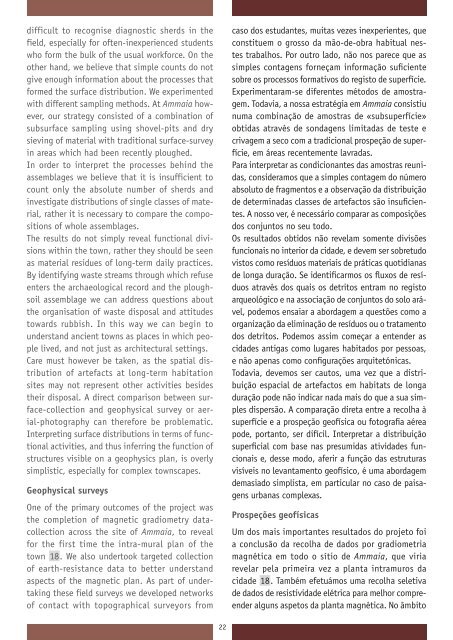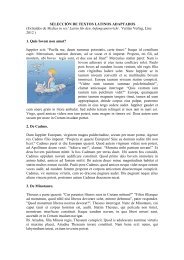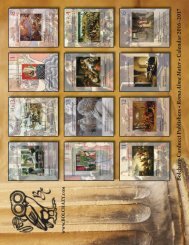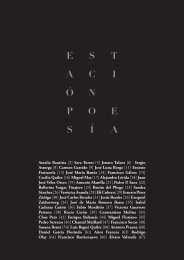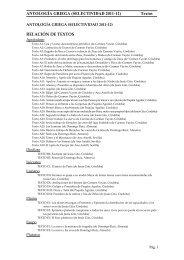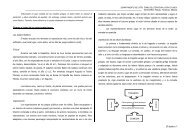Ammaia-Uma-cidade-romana-LR
Ammaia-Uma-cidade-romana-LR
Ammaia-Uma-cidade-romana-LR
You also want an ePaper? Increase the reach of your titles
YUMPU automatically turns print PDFs into web optimized ePapers that Google loves.
difficult to recognise diagnostic sherds in thefield, especially for often-inexperienced studentswho form the bulk of the usual workforce. On theother hand, we believe that simple counts do notgive enough information about the processes thatformed the surface distribution. We experimentedwith different sampling methods. At <strong>Ammaia</strong> however,our strategy consisted of a combination ofsubsurface sampling using shovel-pits and drysieving of material with traditional surface-surveyin areas which had been recently ploughed.In order to interpret the processes behind theassemblages we believe that it is insufficient tocount only the absolute number of sherds andinvestigate distributions of single classes of material,rather it is necessary to compare the compositionsof whole assemblages.The results do not simply reveal functional divisionswithin the town, rather they should be seenas material residues of long-term daily practices.By identifying waste streams through which refuseenters the archaeological record and the ploughsoilassemblage we can address questions aboutthe organisation of waste disposal and attitudestowards rubbish. In this way we can begin tounderstand ancient towns as places in which peoplelived, and not just as architectural settings.Care must however be taken, as the spatial distributionof artefacts at long-term habitationsites may not represent other activities besidestheir disposal. A direct comparison between surface-collectionand geophysical survey or aerial-photographycan therefore be problematic.Interpreting surface distributions in terms of functionalactivities, and thus inferring the function ofstructures visible on a geophysics plan, is overlysimplistic, especially for complex townscapes.Geophysical surveysOne of the primary outcomes of the project wasthe completion of magnetic gradiometry datacollectionacross the site of <strong>Ammaia</strong>, to revealfor the first time the intra-mural plan of thetown 18. We also undertook targeted collectionof earth-resistance data to better understandaspects of the magnetic plan. As part of undertakingthese field surveys we developed networksof contact with topographical surveyors fromcaso dos estudantes, muitas vezes inexperientes, queconstituem o grosso da mão-de-obra habitual nestestrabalhos. Por outro lado, não nos parece que assimples contagens forneçam informação suficientesobre os processos formativos do registo de superfície.Experimentaram-se diferentes métodos de amostragem.Todavia, a nossa estratégia em <strong>Ammaia</strong> consistiunuma combinação de amostras de «subsuperfície»obtidas através de sondagens limitadas de teste ecrivagem a seco com a tradicional prospeção de superfície,em áreas recentemente lavradas.Para interpretar as condicionantes das amostras reunidas,consideramos que a simples contagem do númeroabsoluto de fragmentos e a observação da distribuiçãode determinadas classes de artefactos são insuficientes.A nosso ver, é necessário comparar as composiçõesdos conjuntos no seu todo.Os resultados obtidos não revelam somente divisõesfuncionais no interior da <strong>cidade</strong>, e devem ser sobretudovistos como resíduos materiais de práticas quotidianasde longa duração. Se identificarmos os fluxos de resíduosatravés dos quais os detritos entram no registoarqueológico e na associação de conjuntos do solo arável,podemos ensaiar a abordagem a questões como aorganização da eliminação de resíduos ou o tratamentodos detritos. Podemos assim começar a entender as<strong>cidade</strong>s antigas como lugares habitados por pessoas,e não apenas como configurações arquitetónicas.Todavia, devemos ser cautos, uma vez que a distribuiçãoespacial de artefactos em habitats de longaduração pode não indicar nada mais do que a sua simplesdispersão. A comparação direta entre a recolha àsuperfície e a prospeção geofísica ou fotografia aéreapode, portanto, ser difícil. Interpretar a distribuiçãosuperficial com base nas presumidas atividades funcionaise, desse modo, aferir a função das estruturasvisíveis no levantamento geofísico, é uma abordagemdemasiado simplista, em particular no caso de paisagensurbanas complexas.Prospeções geofísicasUm dos mais importantes resultados do projeto foia conclusão da recolha de dados por gradiometriamagnética em todo o sítio de <strong>Ammaia</strong>, que viriarevelar pela primeira vez a planta intramuros da<strong>cidade</strong> 18. Também efetuámos uma recolha seletivade dados de resistividade elétrica para melhor compreenderalguns aspetos da planta magnética. No âmbito22


